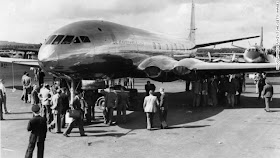Before the Jet Age, when aerodynamic refinement for high speeds was less important, designers could indulge styling whims on parts of aircraft such as in the shape of the vertical stabilizer/rudder element. For example, the de Havilland company favored a shape that for years was a kind of trademark.
One detail that has been comparatively immune to engineering consideration is the arrangement of windows in the cockpit. True, visibility, outside airflow and (since around 1940) pressurization considerations have always been important. But the number of windows, their placement and shape also admit to some aesthetic judgment.
Below is a gallery of airliners with differing cockpit window treatments for your consideration. Wide-body jets are left out to simplify comparisons.
Ford Tri-Motor and Boeing 727
The Ford didn't fly very fast, but was comparativly "clean" for its late 1920s time. The windscreen is sharply V'd. The Boeing 727 is from the mid-1960s. Its window treatment is the same as that of Boeing's original jetliner, the 707 and was continued for the Boeing 737 which remains in production today and for the foreseeable future. The windshield is sloped and V'd and there are two main side windows, the leading (transitional) one having a dropped lower rear corner. Two small cockpit roof windows are above both the pilot's and co-pilot's positions for upward visibility.
Curtiss Condor
The Condor dates from around 1930, but is of the obsolescent biplane configuration. It features large cockpit windows that crudely blend with the otherwise fairly streamlined fuselage.
Boeing 247
The Boeing 247 is considered the first modern airliner. But some of them featured an odd windscreen design that was fashionable in the early 1930s that (I suspect) was intended to be relatively free from raindrop obstruction even though it was aerodynamically questionable.
Douglas DC-2
The more successful DC-2 and DC-3 airliners had a simple combination of a sloped, V's windscreen plus a single side window. This was continued in later four-motor Douglas piston engine transports, though with 2-piece panels on each windscreen V section.
De Havilland Albatross
The beautiful but flawed Albatross of the late 1930s used a similar window configuration. Note the characteristic de Havilland tail.
Boeing 307
The 307 was the first airliner with a pressurized cabin. Perhaps the designers were being cautious given the new technology, so the cockpit features many small windows in a wraparound configuration. For Seattle buffs, the background is a circa-1940 view of Beacon Hill, the tip of Sward Park, Mercer Island and beyond to the east. All of this but the extreme background is now built up.
Curtiss Commando
The Commando was intended as an airliner, but appeared at the start of World War 2 and was built as the C-46 transport/cargo plane. It was used post-war by secondary and tertiary airlines. The designers wanted to attain a curved fuselage profile, so avoided the stepped windscreen arrangement. The window design features excellent downward views to the sides.
Lockheed Constellation
Like the Boeing 307, the Constellation was pressurized and designers opted for small, multiple windows.
Boeing Stratocruiser
The Stratocruiser was derived from the B-29 bomber that also had a rounded front profile and many windows. Yet again, Boeing provided upward views from the cockpit.
Airspeed Ambassador
The Ambassador follows the DC-3/Albatross pattern, but the cockpit roof is shallow and the windows more slit-like.
Avro Tudor
On the other hand, the Tudor had a generously high roofline, but still had slit-like windows.
Bristol Britannia
The Britannia was a large British airliner that had the misfortune of entering service about the time of the 707. Here we find multiple windows plus Boeing-style overhead panes.
SNCASO Bretagne
Given its early post-war debut and mid-wing configuration, I doubt that the Bretagne was pressurized. Which is perhaps why the cockpit windows are so large.
De Havilland Comet
Another beautiful and ill-fated de Havilland design, the Comet was the first jet airliner to enter service, this in the early 1950s. Multiple windows are again in evidence, though in this case the transition windows on each side are triangular.
Vickers Viscount
The commercially successful Viscount featured odd, bulged cockpit area shaping and less windscreen sloping than was common at the time.
Douglas DC-8
Douglas' first jet airliner did not have a V's windscreen treatment. It actually could not because, in place of the V was a central pane. Douglas also used this arrangement on its DC-9/MD-80 twin-engine airliners. Boeing-style ceiling windows were incorporated.
Airbus A320
Europe's Airbus 320's primary windscreen pattern is similar to Boeing's practice except that the rearmost side window is taller the its neighboring transition window. No overhead windows, however.
Boeing 757
Boeing dropped overhead windows for its 757 series. The window treatment and general shape of the nose area have an awkward appearance. This was because Boeing wanted to have the cockpit interiors match those of its wide-body 767 as closely as possible so that airlines ordering both models could simplify pilot training.


















No comments:
Post a Comment